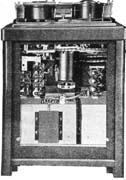Unfortunately, the American Telegraphone Company went out of business in the 1920s without ever producing many machines, so there was little chance for its use to become very widespread. But about that time, the Dictaphone Corporation introduced a new, phonograph-based recorder capable of recording reliably from the telephone lines. American Telephone and Telegraph (AT&T), with a near-monopoly on telephone service in the U.S., forbid its use on any public lines, although a few were used by power companies and railroads on their private lines.

Textophone
In all, it appears that recording devices were not widely used for surveillance in the United States in the period from the introduction of the Telegraphone until the end of World War II, despite the many suggestions that they would be useful for this purpose. Instead, improved electronic devices like the Dictagraph (not made by Dictaphone despite the name) were popular among private detectives and the police. A Dictagraph was a essentially an intercom system, and could be hidden in a room to allow remote monitoring of conversations. But there was still no easy way to record those conversations.
The story was somewhat different in Europe where, for example, (although not very well-documented ) that police and intelligence services in Germany adopted the use of tape recorders in surveillance gathering operations during the 1930s and early 1940s. A somewhat comparable use of recording was undertaken by the U.S. government during World War II to monitor telephone and cable transmissions between the U.S. and Japan. In general , by the end of World War II in 1945, telephone tapping and the making of recordings via hidden microphones was practical and in wider use.